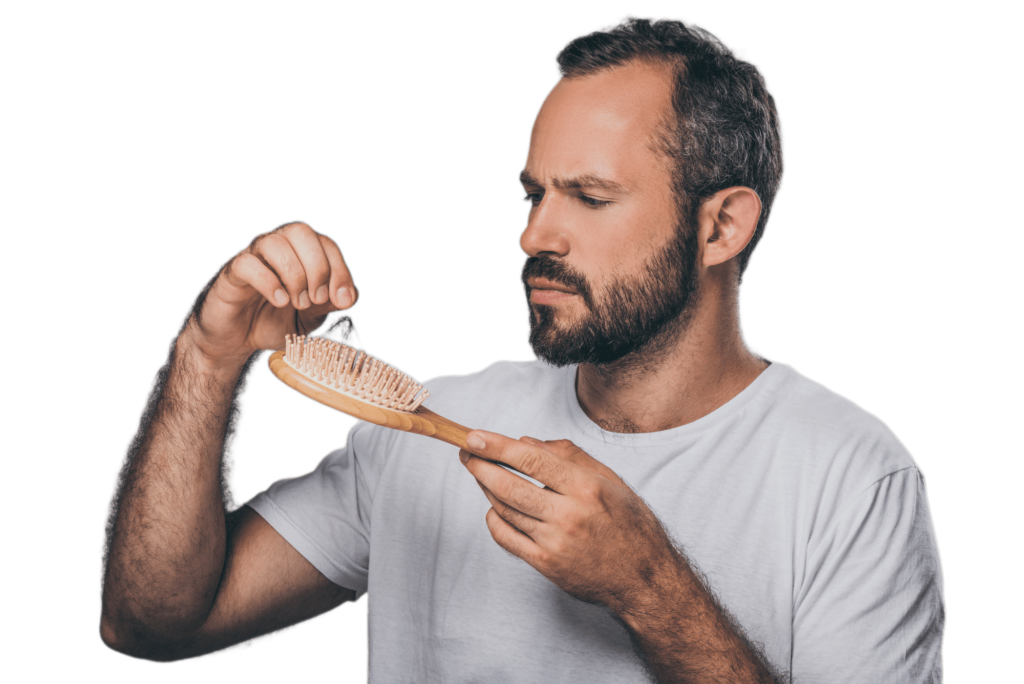Considerations

Causes
HEREDITY
The most common cause of hair loss in men is a hereditary condition called male-pattern baldness. It usually occurs gradually and in predictable patterns — a receding hairline and bald spots on the top of the head.
Male pattern baldness can begin as early as puberty. According to the American Academy of Dermatology Association, by 50 years of age, more than half of caucasian men have a visible sign of male pattern hair loss like noticeable thinning, a receding hairline, or balding. About 80% of all men show signs of male pattern baldness at the age of 70.
Male pattern baldness (MPB) is caused by the presence of Dihydrotestosterone (DHT) – a hormone that contributes to the development of sexual structures and characteristics in people assigned male at birth.
As an adult, your body converts about 10% of your testosterone (the main androgen) into DHT each day. This takes place in the genital skin and prostate.
DHT has different roles in different life stages — mainly during fetal development and puberty. Unlike testosterone, DHT doesn’t play a significant role in maintaining male physiology in adulthood. Effects mainly include prostate enlargement and male pattern hair loss in adulthood.
DHT is essential for the formation of the male external genitalia, including the penis and scrotum, in a fetus. DHT also helps with the formation of the prostate. During puberty, DHT promotes further growth of the penis and scrotum. It’s also the main androgen that’s responsible for:
- Facial hair
- Body hair
- Pubic hair
- Prostate growth
- Benign prostatic hyperplasia
- Prostate cancer
- Androgenic alopecia (male pattern hair loss)
- Polycystic ovarian syndrome (PCOS)
Increased DHT activity at your hair follicles is responsible for MPB as it causes the miniaturisation of the hairs, shortening the hair growth cycle and their subsequent fall. Besides the presence of DHT, the genetic component which makes the androgen receptors (situated in the graft) to be more or less active will have a big role in hair loss too.
You’re more likely to have male pattern baldness if you have a family history of it. If your grandfather(s), father or brother(s) have male pattern baldness, your odds of having it are higher. If your maternal grandfather has male pattern baldness, there’s a good chance that you’ll have male pattern baldness as well. However, there may be a link between male pattern baldness and your father. If your father is bald, you’re twice as likely to have male pattern baldness.
Nowadays, there are medications that reduce the conversion of testosterone to DHT hence they help to slow down and/or stabilise the hair loss process. But, it is very important to note that male pattern baldness is a chronic disease and the medication will just help to slow down the process and not to cure (stop) it.
PHYSICAL AND EMOTIONAL STRESS
Physical and emotional stress can cause the loss of half to three quarters of the hair on the scalp, however, it is not directly linked to increased DHT levels. Instead, physical and emotional stress shift hair follicles into the resting phase too quickly, preventing them from growing properly. This type of hair loss is called telogen effluvium. The hair tends to fall out in large numbers while shampooing, combing or passing your hands through the hair. You may not notice this for weeks or months after the stressful episode. The shedding will decrease after a period that may last up to 6- 8 months. Telogen effluvium is usually temporary, and the hair should start to grow back roughly 6 months after the stress has resolved. But in some cases, it may be prolonged or even become chronic.
Emotional stress can trigger hormonal imbalances, which lead to hair loss. It can also trigger a specific type of alopecia called alopecia areata. This is characterised by sudden bald patches on the scalp, which can spread to cover the entire head.
The causes of this type of hair loss are:
- Severe nutritional deficiency due to extreme dieting (meal-replacement drinks, diets that are overly restrictive on the types of food that are and are not allowed to be consumed, low-carb or no-carb diets)
- Sudden and extreme weight loss
- Severe and / or acute illnesses
- Intense emotional stress (due to shock, traumatic events etc)
- Major surgery
- Drugs; beta-blockers, blood thinners, antidepressants, cholesterol-lowering drugs, certain nonsteroidal anti-inflammatory drugs (NSAIDs) and hormone-related drugs like thyroid medication, hormone replacement therapies or steroids."
OTHER CAUSES
Other causes of hair loss, especially if it is an unusual pattern, include:
- Alopecia areata (patches of baldness that occur on the scalp, the beard and possibly the eyebrows and the eyelashes)
- Anemia
- Autoimmune disorders such as lupus
- Burns
- Certain infectious diseases such as syphilis
- Hormonal changes
- Thyroid diseases
- Radiotherapy
- Tinea capitis (ringworm of the scalp)
- Tumor of the ovarian or adrenal glands
